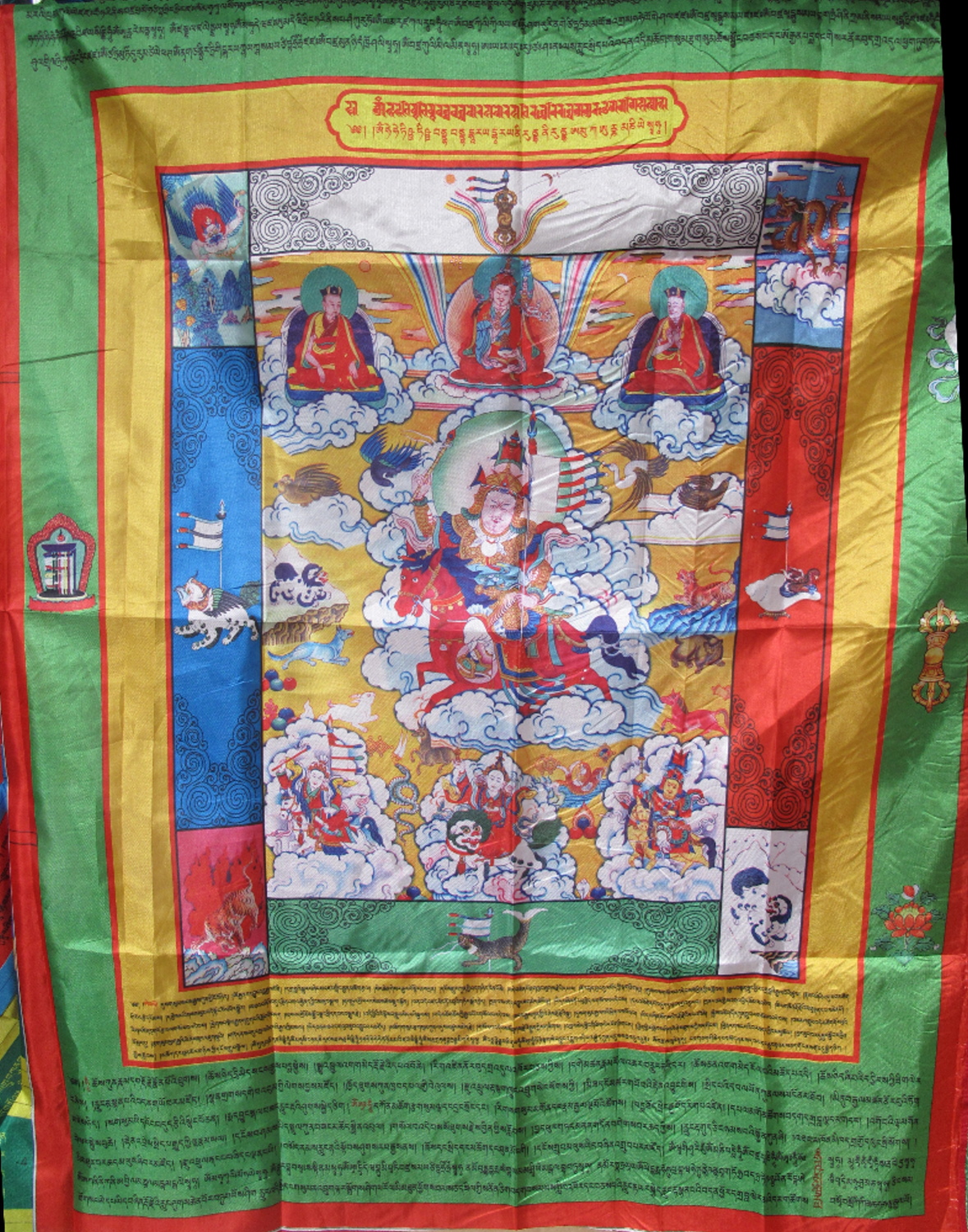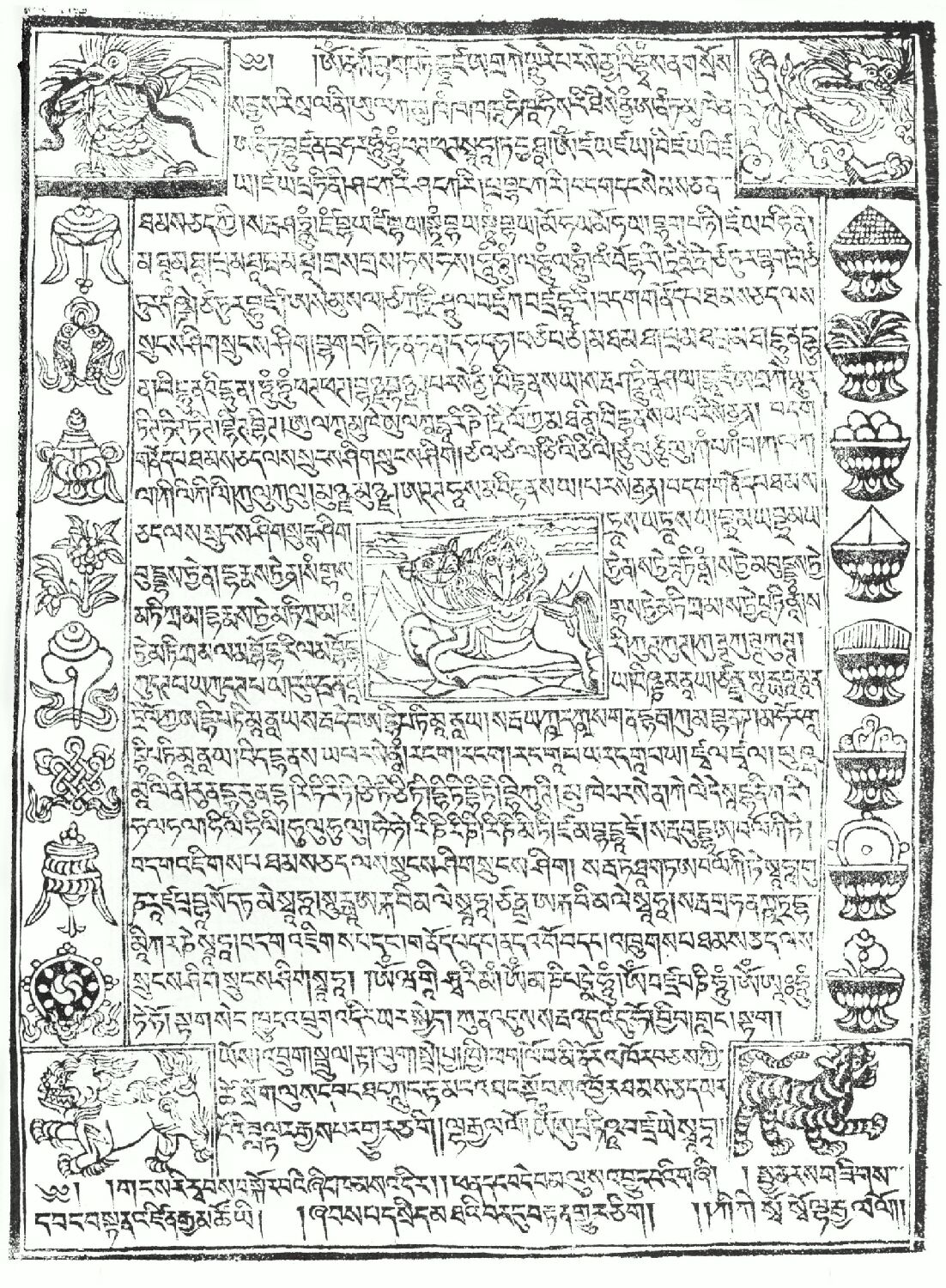Buddhist practice and Buddhist art have been inseparable in the Himalayas ever since Buddhism arrived to the region in the eighth century. But for the casual observer it can be difficult to make sense of the complex iconography. Not to worry—Himalayan art scholar Jeff Watt is here to help. In this “Himalayan Buddhist Art 101” series, Jeff is making sense of this rich artistic tradition by presenting weekly images from the Himalayan Art Resources archives and explaining their roles in the Buddhist tradition.
Prayer Flags, Part 2
 Prayer Flags in Tibet are called lungta (“wind horse”). Traditionally, the flags would always be recognizable by the drawings of a horse at the center of the composition surrounded by four other animals—a lion, tiger, bird, and dragon. Many modern prayer flags have, however, replaced the horse with other subjects, such as popular deities and teachers like Padmasambhava. One very popular example is the prayer flag depicting the quasi-mythical Tibetan hero King Gesar. The newer personalized flags generally retain the four surrounding animals in the four corners—sometimes by their written names instead of images.
Prayer Flags in Tibet are called lungta (“wind horse”). Traditionally, the flags would always be recognizable by the drawings of a horse at the center of the composition surrounded by four other animals—a lion, tiger, bird, and dragon. Many modern prayer flags have, however, replaced the horse with other subjects, such as popular deities and teachers like Padmasambhava. One very popular example is the prayer flag depicting the quasi-mythical Tibetan hero King Gesar. The newer personalized flags generally retain the four surrounding animals in the four corners—sometimes by their written names instead of images.
 The identities of the four animals have not always been consistent. On early Bon prayer flags, a white yak was counted as one of the four. In addition, the bird depicted on Buddhist flags is believed to be a garuda, which has its origins in Indian culture and literature, while the bird image on Bon flags has a different meaning and history. These are all minor cultural differences.
The identities of the four animals have not always been consistent. On early Bon prayer flags, a white yak was counted as one of the four. In addition, the bird depicted on Buddhist flags is believed to be a garuda, which has its origins in Indian culture and literature, while the bird image on Bon flags has a different meaning and history. These are all minor cultural differences.
Buddhist prayer flags are generally amalgams of Indian Buddhist banners and Tibetan lungta. Chief among Buddhist texts displayed on the Indian banners, and now on Tibetan prayer flags, is the long dharani, a string of letters or syllables very similar to a mantra, of the wrathful female deity Dvajagrakeyura. She is an emanation, or creation, of the Buddha, just like the long-life goddess Ushnishavijaya, who was born from a ray of light emanating from the ushnisha atop the Buddha’s head.
 The tantric source literature of Dvajagrakeyua explains the importance of creating banners and displaying the long dharani—composed of several hundred syllables—for the benefit of all. Despite the lengthiness of the text, the prayer flag still fits the four animals in the corners and sometimes even retains a small image of the wind horse at the center of the composition.
The tantric source literature of Dvajagrakeyua explains the importance of creating banners and displaying the long dharani—composed of several hundred syllables—for the benefit of all. Despite the lengthiness of the text, the prayer flag still fits the four animals in the corners and sometimes even retains a small image of the wind horse at the center of the composition.
The wind horse together with the group of four animals was certainly the earliest form of a prayer flag as we recognize it today. Perhaps the concept of a wind horse that spreads good wishes by currents of air was just too big an idea to be constrained by a single fixed formula or design. The prayer flag has very quickly traveled and adapted to different continents and cultures, becoming more and more a universal symbol for happiness and peace.
Gesar Prayer Flag. Private Collection.
The Four Animals of Dignitiy. Himalayan region, 19th century. Buddhist lineage. Private Collection.
Dvajagrakeyura prayer flag. Himalayan region, 19th century. Buddhist lineage. Private Collection.
Thank you for subscribing to Tricycle! As a nonprofit, we depend on readers like you to keep Buddhist teachings and practices widely available.